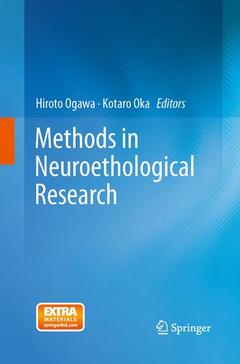Description
Methods in Neuroethological Research, Softcover reprint of the original 1st ed. 2013
Language: English
Subjects for Methods in Neuroethological Research:
Publication date: 08-2015
Support: Print on demand
Publication date: 07-2013
175 p. · 15.5x23.5 cm · Hardback
Description
/li>Contents
/li>Comment
/li>
The rapid progress of neuroscience in the last decade can be largely attributed to significant advances in neuroethology, a branch of science that seeks to understand the neural basis of natural animal behavior. Novel approaches including molecular biological techniques, optical recording methods, functional anatomy, and informatics have brought drastic changes in how the neural systems underlying high-level behaviors such as learning and memory are described. This book introduces recent research techniques in neuroethology, with diverse topics involving nematodes, insects, and vertebrates (birds, mice and primates), divided into sections by research method. Each section consists of two chapters written by different authors who have developed their own unique approaches. Reports of research in ?model animals? including C.elegans, Drosophila, and mice, which were not typical specimens in conventional neuroethology, have been deliberately selected for this book because a molecular genetic approach to these animals is necessary for advances in neuroethology. Novel methodology including optical recording and functional labeling with reporter genes such as GFP has been actively used in recent neurobiological studies, and genetic manipulation techniques such as optogenetics also are powerful tools for understanding the molecular basis of neural systems for animal behavior. This book provides not only these new strategies but also thought-provoking statements of philosophy in neuroethology for students and young researchers in the biological sciences.
Part 1. Behavioral analysis
Chapter 1. Behavioral Analysis in Caenorhabditis elegans.
Author: Tsukada, Y., Mori, I. (Nagoya Univ., Japan)
Chapter 2. Classical conditioning of the proboscis extension reflex inthe honeybee.
Author: Matsumoto, Y.(Hokkaido Univ., Japan), Sandoz J-C (CNRS - University Paul Sabatier, France). Giurfa,M. (CNRS, France)
Part 2. Electrophysiology
Chapter 3. Mining spatio-spectro-temporal cortical dynamics: aguideline for offline and online electrocorticographic analyses.
Author: Chao, Z., Fujii, N. (RIKEN BSI, Japan)
Chapter 4. Computational analysis of behavioural and neural datathrough
Bayesian statistical modelling.
Author: Wai MunChan, R. and Gabbiani, F. (BaylorCollege of Medicine, USA)
Part 3. Optical recording techniques
Chapter 5. In vivo Ca2+ imaging of neuronal activity.
Author: Ogawa, H. (HokkaidoUniv,, Japan), Miller, J.P. (Montana StateUniv., USA)
Chapter 6. Optical Imaging techniques for investigating the earthworm nervous system and its function.
Author: Oka, K. (Keio Univ., Japan)., Ogawa H. (Hokkaido Univ., Japan)
Part 4. Optogenetics
Chapter 7. Monitoring neural activity with genetically-encoded Ca2+indicators.
Author: Kamikouchi, A. (NagoyaUniversity, Japan), Fiala A. (Georg-August-Universityof Göttingen, Germany)
Chapter 8. Behavioral control by light-exciting and silencing neuronalactivity.
Author: Cetin A. (Salk Inst, USA)., Komai, S. (NaraInst. Sci. Tech., Japan)
Part 5. Molecular biological techniques
Chapter 9. Detecting neural activity-dependent immediate early geneexpression in the brain.
Author: Wada, K. (Hokkaido Univ., Japan), Chen, CC. (Duke Univ, USA), Jarvis E.D. (Duke Univ, USA)
Chapter 10. Epigenetic regulation of gene expression in the nervoussystem.
Author: Hatakeyama, D. (Tokushima Bunri Univ., Japan), Tierling, S. (Saarland Univ., Germany), Kuzuhara, T. (TokushimaBunri Univ., Japan), Müller U.(Saarland Univ., Germany)
Easy-to-follow protocols and tangible advices help the reader to put experiments into practice quickly
Variety of applications of leading-edge research techniques extend the readers’ scope of the experimental approach
Wide range of topics on various species of materials including non-model animals with unique behaviors guide the readers to modern neuroethology
Includes supplementary material: sn.pub/extras
These books may interest you

The Oxford Handbook of Molecular PsychologyA Unified History of the United States and Canada 173.95 €



